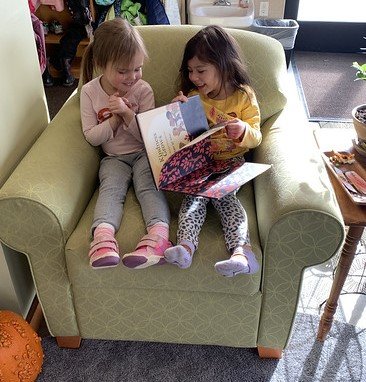Kindergarten Readiness
One question that is often asked by parents is, “What does the preschool do to prepare children for kindergarten?” As a teacher this can be a tricky question to answer as there are many different aspects to preparing children for kindergarten and a lot of different opinions about what kindergarten preparedness looks like. However, most parents when they ask this question seem to be wondering, “How are academic skills like reading and math taught?”
Here at All Seasons, you won’t find mass produced posters on the wall of the alphabet or numbers. You also won’t find a rigid schedule or children in small groups moving from one table to another every fifteen minutes with a teacher instructing them how to do it properly. What you will find is children building with blocks, climbing a boulder outside with their friends, baking cookies in a small group, making cards and delivering them to the grandparents who live upstairs, and setting up tables for lunch. Through each of these activities children are learning both academic skills and social skills that set the foundation not only for kindergarten but for their whole lives.
When children are baking, they are learning how to follow steps of a recipe in sequence, count the number of cups of flour, and take turns. When making a card for a grandparent and delivering it, they are practicing their writing or pre-writing skills, working on number identification when looking for the apartment number where the grandparent lives, and learning that the smallest acts of kindness can bring large amounts of joy. When setting the table for lunch, children are learning to take responsibility for their space, along with counting the number of cups that are needed, working on their fine motor skills as they open up the milk cartons, and making sure that there is a chair for every child and teacher who is there that day. Learning at All Seasons is embedded in the children’s activities throughout the day. It is functional and meaningful to the child and sets the foundation for lifelong learning.
If you want to embed more learning at home with your child, here are some things to try:
• Try not to “quiz” your child, such as asking, “Can you count 10 blocks?” It might take the fun and self-motivation out of their activity.
• Instead, try making it an invitation, and doing it together: “I wonder how many blocks you used in your tower. 1,2,3…”
• Count the stairs you walk up or down.
• Cook with your child. There are so many ways to include learning skills through cooking and baking: measurement, counting, referring to a written recipe, etc.
• When putting away their toys, challenge children to sort them by color, size, or shape. “Let’s put away all the blue blocks first.”
• When reading books, point out different letters you see: “Look, I see a ‘B’ on the cover.” or words that rhyme: “Oh, did you hear that? Cat and hat. Those sound the same at the end.”
• Write the words your child dictates for a thank-you note or a card to a friend or neighbor. Say the sounds as your child watches you write the letters. If they are interested, have them write or copy a few words or write their name themselves.
• When washing hands with your child, count to thirty with them while they scrub with the soap.
• Remember your child is unique and each child will learn things at their own pace and at their own time.
• Reach out to your child’s teachers with any questions or concerns.



